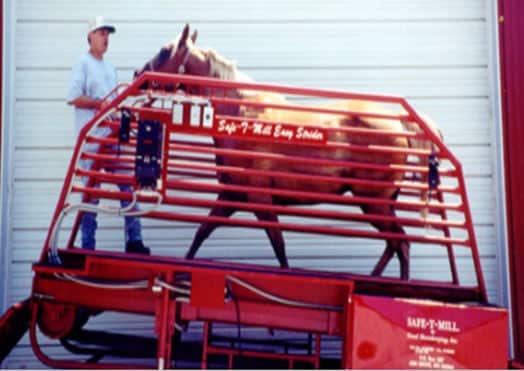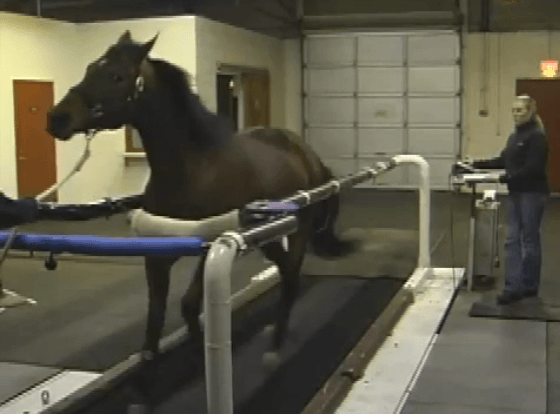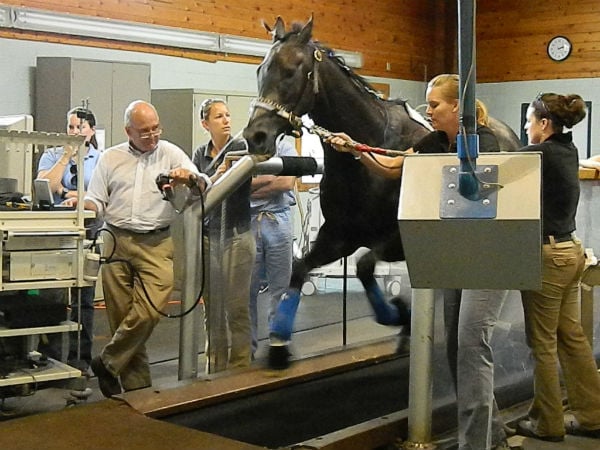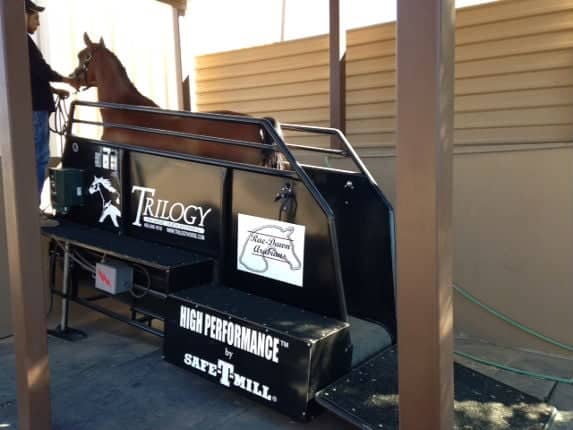Improve Fitness and Evaluate Problems With a Horse Treadmill

 Gym treadmills can be great tools to help us get into shape for show season. It only makes sense that a similar workout would work well for your horse too! As it turns out, horse treadmills have been around for several decades and are a valuable tool to help maintain fitness levels, rehabilitate injuries, and provide a controlled environment for researchers to study horses in motion. We spoke with Ray Drennan of Safe-T-Mill horse treadmills about the benefits and use of these machines. If you have the money, this is an investment you should consider for your own farm.
Gym treadmills can be great tools to help us get into shape for show season. It only makes sense that a similar workout would work well for your horse too! As it turns out, horse treadmills have been around for several decades and are a valuable tool to help maintain fitness levels, rehabilitate injuries, and provide a controlled environment for researchers to study horses in motion. We spoke with Ray Drennan of Safe-T-Mill horse treadmills about the benefits and use of these machines. If you have the money, this is an investment you should consider for your own farm.
What are the Benefits of a Horse Treadmill?
Horse treadmills operate much like human treadmills but on a much larger scale. As opposed to the round pen or racetrack work, the horse is moving forward on a cushioned moving belt at a known speed. Treadmill work takes out variables like weather, rider error, footing issues, or inconsistent pace.
“A treadmill, as far as training horses, is as good as it gets,” shared Ray Drennan. “You can do twenty minutes on a treadmill that equals an hour by hand.” Ray Drennan is the owner of the patent for the first American-made horse treadmill called Safe-T-Mill operating out of Missouri and Oklahoma.
There are several types of horse treadmills including large high-speed machines that are built permanently into the ground and hydro-treadmills that can fill with water. Smaller machines from companies like Safe-T-Mill provide self-contained options that allow some limited portability between farms. One of the main benefits of this type of treadmill is the ability to incline the surface up to 10% grade. This allows horses to do artificial hill work to increase fitness or strengthen problem areas like the stifle. Ray also explained, “It’s great for cardiovascular and respiratory.”
Once horses are trained to use these home units, they can provide a safe contained area to work your horse on bad weather days. The cushioned belt is designed to reduce impact on their legs. Plus, horses that have been confined for injury can be gradually reintroduced to exercise rather than risking re-injury from over-exuberant pasture play. Ray shared, “You can control every movement they’ve got.”
Horse Treadmills as a Research and Veterinary Tool
Larger, high-speed horse treadmills are often used in university research facilities or veterinary offices to access horses’ health. These machines are used because it is easier to diagnose certain medical conditions like ‘roaring’, when the horse is breathing heavily during real exercise. In addition, the staff can easily take blood samples, check enzyme levels, hook up EKG leads, and even use a camera with a scope to access respiratory conditions.
These types of medical tests would be much harder or even impossible if they were moving a horse in a traditional round pen or track. The high-speed machines go much faster than the home units and can reach speeds of 45 mph to match the full gallop of a thoroughbred racehorse. Check out this great video of an equine treadmill demonstration from Cornell University.
This high-speed horse treadmill is built into the ground and goes up to 45-mph. This allows medical staff to access the health of the horse during exercise. Photo Credit and Video Link
Another benefit is the ability to see the horse in motion from 360 degrees at many different speeds. They are a better able to diagnose lameness issues. Treadmills give veterinary students the ability to really study the horse’s motion so they can learn what ‘normal’ movement should look like.
If you are having trouble diagnosing issues with your horse’s health, it is possible to take them to these treadmill facilities to be evaluated. One example of this service is the New Bolton Center Hospital, which is part of the University of Pennsylvania Veterinary School.
The New Bolton Hospital Center in Pennsylvania has a treadmill facility to help diagnose horse health issues. Photo Credit
Training a Horse to Use a Treadmill
It is actually much easier to train a horse to use a treadmill than you would think. Once the horse is accustomed to walking onto the rubber belt, it is instinctual for them to walk forward when the belt begins to move. Within ten minutes, you can have that same horse at a full canter.
Ray Drennan has broken over 2,000 horses to the treadmill. His machines are completely self-contained where the horse walks up into the machine rather than onto an in-ground unit. Ray explained, “By the third time they’re in it, they’ll walk in and start trying to walk before you even get started.”
There are several safety features on horse treadmills that help prevent injury. A ‘quick release’ lever is in the back in case the horse needs to exit out the back of the machine in a hurry. There is also a full-vented front, a front chest bar, and an immediate shut down feature.
The larger in-ground units typically have a front chest bar and a back strap with bars on the side. A handler should always be present to stand with the horse and take action if the horse becomes distressed.
As a side benefit, young horses that are comfortable walking up onto one of Ray’s treadmills are easily loaded onto a horse trailer. Ray chuckled that they do tend to pick up their feet once on the trailer’s rubber mat thinking it’s going to start moving for them.
How Can You Get a Horse Treadmill For Your Farm?
If you are interested in purchasing a horse treadmill for your farm, you should be ready to spend some money. A basic horse treadmill will cost anywhere from $13,000 for a miniature horse size up to $32,000. There are also horse hydro-treadmills that can be filled with water for added buoyancy and resistance that cost from $68,000 to $150,000.
Smaller farm treadmills reach speeds of 8-16 mph while larger machines at universities and clinics reach speeds of 45 mph.
Smaller treadmills vary in features from those that go 8mph up to 16mph. The larger units used at research and veterinary facilities can reach speeds of 45mph. Horse treadmills should have a rubber-cushioned belt overtop of several other layers to provide a comfortable surface for the horse to work. Some machines are completely self-contained so they can be moved with a forklift from farm to farm. This is especially attractive for those in the racing industry who often transport treadmills from their home farm to the racetrack. Larger treadmills are built into the ground as a permanent structure.
If you’d rather exercise your horse the old-fashioned way (on his back!) then perhaps you will see a horse treadmill one day at a visit to the animal hospital. It is thanks to these machines that the medical staff is able to access lameness and learn about horse physiology.
Overall, horse treadmills provide an excellent tool to maintain fitness levels, access injuries, provide rehabilitation, and allow for equine research. If you’re interested, check out the Safe-T-Mill machines to bring treadmill workouts to your own farm!
Questions:
- Have you heard of stories where horse treadmills are used to keep a horse fit or evaluate an injury?
- How do you think your horse would respond to this type of training?




